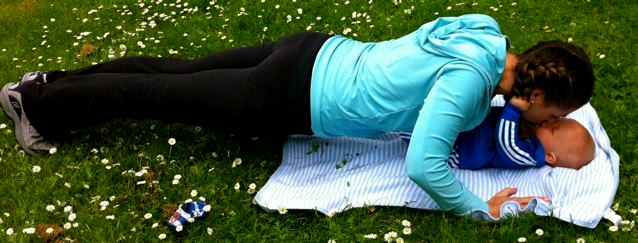Unfortunately, there is no simple answer to this question, and I’m going to use “running” as an example of high-impact exercise in this article.
We’ll start with a hormone called relaxin which is released into your system in the early stages of your pregnancy. Relaxin relaxes your muscles/joints/ligaments to help prepare your pelvis for childbirth. BUT, relaxin doesn’t just affect your pelvis, it affects every joint in your body, AND, it stays in your system for up to six months (sometimes longer) after birth, which makes your body more susceptible to injury.
As a result, your ankles, knees, shoulders, pelvis and spine aren’t as stable as they once were.
So, think of the chain of events when you run, from when your heel strikes the pavement, to when it lifts off the ground again to take the next stride – almost every joint in your body (which is in an unstable state remember), gets jolted. The risk of injury is high, and that’s why low-impact activity is prescribed for postnatal women.
A supportive running shoe is a must for any runner, regardless of their experience. Get a proper foot assessment before you pound the pavement again, and remember, it’s not uncommon for pregnant women’s feet to increase by up to a shoe size, so be sure your running shoes fit!
Regardless of whether you’re breast or bottle feeding, chances are, your breasts will feel uncomfortable when performing high-impact exercise, unless you’re wearing a properly fitted sports bra.
Next up is your pelvic floor. If it isn’t strong, chances are, you’ll wet yourself the first time you go out for a run and could do yourself some everlasting damage! Not an attractive look, or indeed a sensible idea.
If you’re having to wear, or even contemplating wearing an incontinence pad, ladies…let’s think this through again.
So, you can start running again, if, and only if:
- Your pelvic floor is in check–no pain, leakage, heaviness etc (my recommendation would be to see a Women’s Health Physical Therapist)
- You’ve done a couple of months’ worth of regular, consistent work on pelvic stabilization exercise ie: Pilates or core-based exercise to ensure your pelvic floor, core and abdominals are in a supportive state
- Running was a regular activity for you prior to getting pregnant
- You’ve been completing regular postpartum specific full-body strength training to realign, restore and rehabilitate
- You’ve been gradually advancing your cardio training beginning with low impact options such as swimming, walking, elliptical, biking.
- You’ve invested in a good sports bra, AND you’re wearing new, shiny, well-fitting running shoes
Experienced runners know that the only way to increase their speed and stamina is to do “interval training”, and I would ALWAYS recommend beginning with walking intervals until they become easy. At that time, you can introduce a light jog and increase from there.
So considering this information, are you sure you’re ready to return to running? Could you stand to do a bit more core work first? Maybe see a Pelvic Floor PT?
I want you to take the necessary, deliberate steps of recovery initially so that you can return to higher intensity exercise sooner and safely!
[hr]Work with me one-on-one for an individualized program to reach your health
and fitness goals!Check out the Bodies for Birth page on Facebook for daily posts this week regarding prenatal fitness! Join our private Facebook group for ongoing access to me, to connect with other moms, for answers to your questions, for support and resources! You can work with me one-one-one via Skype or in-person.
Visit www.bodiesforbirth.com to learn more! If you found this helpful, why not share?
[hr] Written in collaboration with Claire Mockridge, www.clairemockridge.com
Claire Mockridge is a qualified and experienced Personal Trainer, Fitness Instructor and Pilates Teacher with a passion for fitness and wellbeing. Teaching general exercise and Pilates classes in West Bridgford, Nottingham, Claire has a specialism in pregnant and postnatal fitness. See more at: http:www.clairemockridge.com


